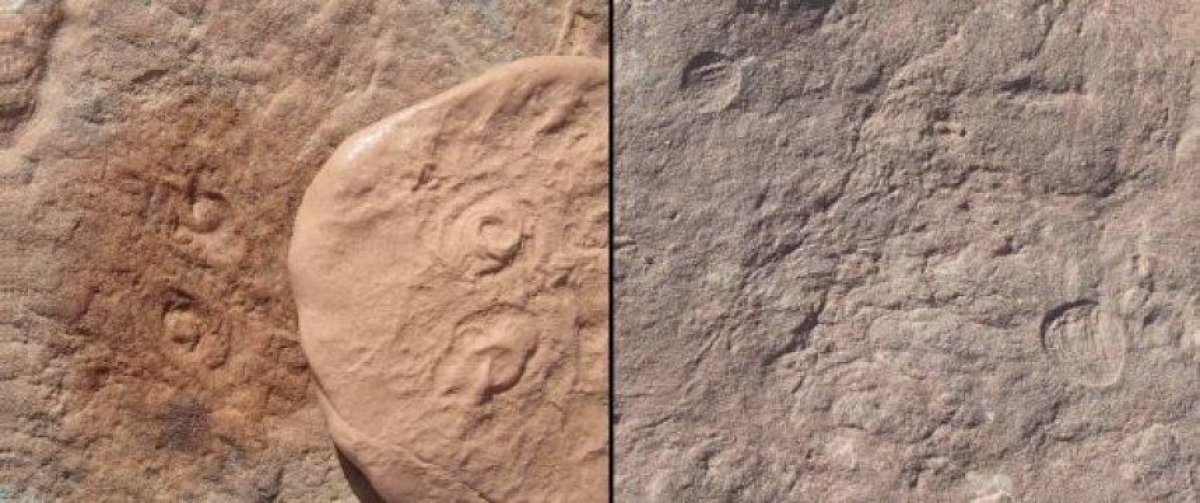Between 580 and 540 million years ago, toward the end of the so-called Ediacaran Period, the first complex animals emerged in Earth's shallow oceans.
Now, scientists from the University of California, Riverside (UCR) have discovered the fossils of two bizarre new creatures from this period—and they've named them after former President Barack Obama and renowned British naturalist Sir David Attenborough.
Obamus coronatus was a small disk-shaped creature with raised spiral grooves on its surface and measured between 0.2 and 0.8 inches (0.5 and 2 centimeters) across. It likely did not move around much but lived embedded in the ocean mat—a thick layer of organic matter that once covered the floor of Earth's early oceans. O. coronatus was named after the former president because of his passion for science, researchers said.
Attenborites janeae, on the other hand, was a tiny egg-shaped critter, covered in grooves and ridges, that would have somewhat resembled a raisin. It measured less than a centimeter, or 0.4 inches, across. The animal was named after the famed naturalist because of his role in popularizing science and support of paleontology.
A paper describing the discovery of O. coronatus has been published in the Australian Journal of Earth Sciences. A paper on the finding of the A. janeae fossil is awaiting publication in the same journal.
Both of the fossils were embedded in fine-grained sandstone from a particularly well-preserved fossil bed in the Flinders Ranges region, in southern Australia.
"I've been working in this region for 30 years, and I've never seen such a beautifully preserved bed with so many high quality and rare specimens, including Obamus and Attenborites," Mary Droser, a professor of paleontology at UCR's Department of Earth Sciences, said in a statement.
The animals form part of the Ediacaran biota—a unique collection of soft-bodied organisms from the Ediacaran Period that have been preserved as fossils. These organisms represent an important milestone in the evolution of life on Earth as they immediately precede the so-called Cambrian Explosion—a rapid increase in biodiversity when most of the major animal groups appear in the fossil record.
It is unclear how the Ediacaran biota relate to modern animals, because they largely disappeared with the Cambrian explosion. Macroorganisms—organisms that can be seen with the unaided eye—from the Ediacaran appear to have been completely replaced by those that evolved during the explosion, for example. And most of the body plans of existing animals derive from creatures that first appeared in the Cambrian fossil record.

But the reasons for the apparent disappearance of the Ediacaran biota, as well as the nature of the evolutionary relationships between life-forms in the Ediacaran and Cambrian eras, are still up for debate.
Determining where Ediacaran organisms fit on the tree of life has proven challenging. Some scientists have expressed doubt as to whether many of them can even be classed as animals. Most of the larger examples are quite distinct from later life-forms: Among them are large, flat quilt-like creatures; tube-shaped organisms; and plant-like, leaf-shaped critters.
The two new specimens have a body plan that is "unlike anything else that has been described," Droser said. "We have been seeing evidence for these animals for quite a long time, but it took us a while to verify that they are animals within their own rights and not part of another animal."
Uncommon Knowledge
Newsweek is committed to challenging conventional wisdom and finding connections in the search for common ground.
Newsweek is committed to challenging conventional wisdom and finding connections in the search for common ground.
About the writer
Aristos is a Newsweek science reporter with the London, U.K., bureau. He reports on science and health topics, including; animal, ... Read more
To read how Newsweek uses AI as a newsroom tool, Click here.








